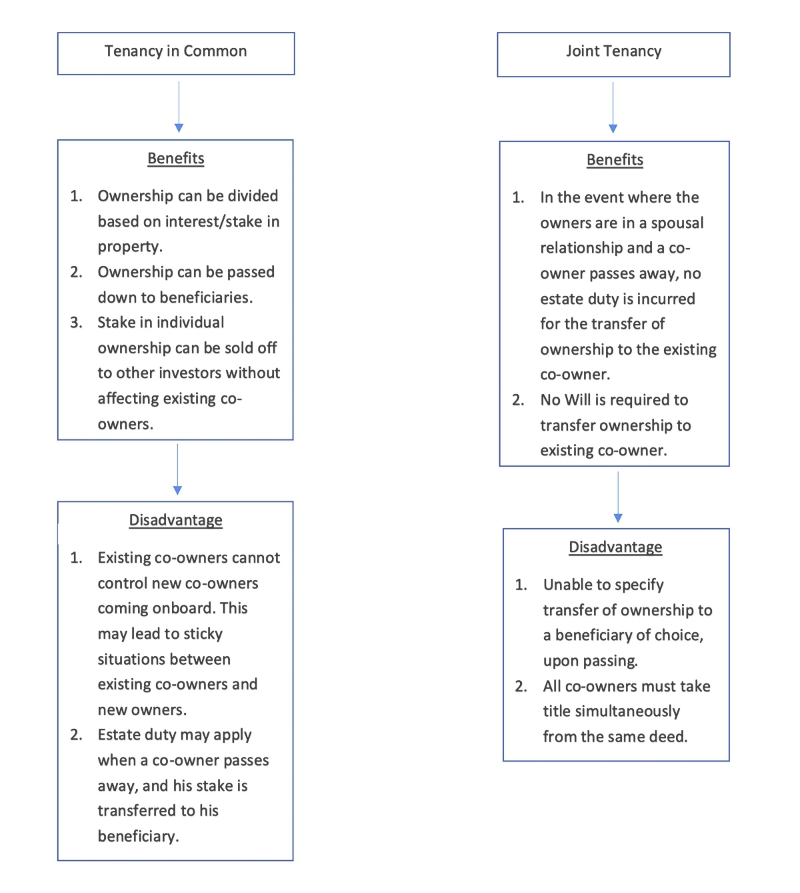Tenancy in common vs joint tenancy: Which should you choose for your HDB flat


In Singapore, you can own a piece of land or property in Singapore as a sole owner or as a co-owner.
Sole ownership occurs when a single person owns complete interest in the property. Generally, the individual upon his passing, can will away his right, title and interest in the property. In the absence of a valid will, the property will be distributed in accordance with the Intestate Succession Act (Cap. 146).
When two or more persons own a piece of land or property, they are deemed as co-owners of the land. There are two forms of co-ownership in Singapore – tenancy in common and joint tenancy.
Tenancy in Common is when each co-owners have an ‘undivided share’ in the land or property. Although the piece of land or property remains undivided physically, each owner can in fact identify his own separate and distinctive share in the property.
This division, will be clearly specified in the title deed of the property. At the passing of any of the co-owner, his ownership in the flat will be transferred to his beneficiaries either as per his will or in its absence, in accordance with the Intestate Succession Act (Cap. 146).
For example, if three people were to pool their funds to own a house, each co-owner can have an agreement to divide their shares in the property appropriately based on their rate of contribution.
For example, tenant A can have 40 per cent, tenant B can have 25 per cent and tenant C can have 35 per cent.
If tenant A were to pass on, his 40 per cent ownership in the flat will be transferred to his beneficiaries while tenant B and Cs’ ownership remains unchanged.
Unlike tenancy in common, under the joint tenancy, the co-owners cannot identify a specific share. If three people were to co-own a house as joint tenants, all three would own the whole house but none of them can individually identify their specific share.
If anyone of the three joint tenants dies, the remaining two will own the whole house. No part of the house will go to the successor of the deceased tenant. This concept is called the ‘right of survivorship’ and is the main distinctive feature of joint tenancy that distinguishes it from tenancy in common.
There are further two concepts relating to the co-ownership. They are unit of possession and unit of interest.
The unit of possession is applicable to both joint tenancy and tenancy in common. It means that each owner is entitled to possession of the whole land and cannot be excluded from any part or be sued for trespass.
As for the unit of interest, it is only applicable for joint tenancy. It defines that the interests of all co-owners must be equal in quality (tenure) and quantity/duration (eg. statute).

Tenancy in common may be the most common form of home ownership when it comes to private properties as it allows the greatest flexibility for co-owners. This form of ownership allows co-owners to jointly purchase high value properties and hold such investments based on their share in the property.
This form of ownership, provides liquidity to their holdings without affecting the status of existing co-owners. Furthermore, it allows the transfer of their ownership to their beneficiaries upon death.
Tenancy in common is a suitable form of home ownership for unrelated parties engaging in crowd funding or shared financing of properties.
Given the strict eligibility rules on HDB home ownership, joint tenancy on the other hand, maybe the more commonly subscribed form of home ownership amongst HDB owners.
One of the biggest advantages is that, should one of the co-owners were to pass away during the tenure of the property, it allows the other joint tenants to take over the remaining home ownership without having to infer back to the will or Intestate Succession Act.
Furthermore, for co-owners in a spousal relationship, the transfer of ownership will not incur any estate duty, which they will otherwise would, under the tenancy in common or sole ownership.
As such, joint tenancy is a preferred form of home ownership for those in a spousal relationship with a single home or for those considering from an estate planning perspective.
This article was first published in Dollars and Sense.